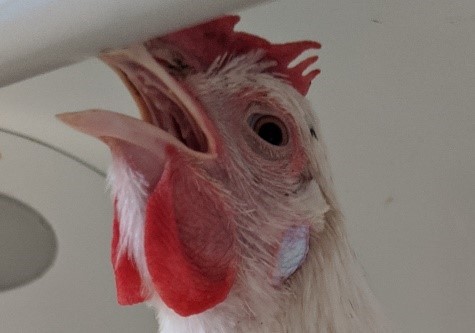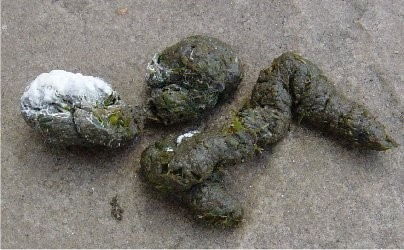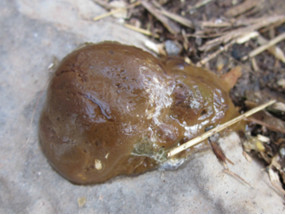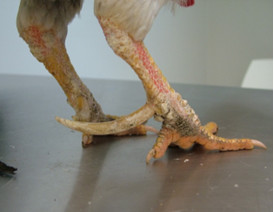You should watch for signs of disease or distress in chickens on a daily basis. This starts with a good look at the chicken before you handle them, and then a closer exam if warranted.
Looking at the chicken from the distance
The examination should start with looking at the chicken from a distance. The bird’s respiratory rate and effort, gait and general demeanour can be assessed. Mouth-breathing (when not hot or stressed), exaggerated sternal and wing lift (heaving the keel and wings when breathing), and audible respiratory noises (gurgles, whistles, etc) are indicators of respiratory disease or compromise.

Frequent sneezing, often accompanied by head shaking, can indicate upper respiratory tract disease. Lameness and wing droop should be investigated more closely. Weakness, lethargy, and a dull demeanour are non-specific indicators of illness.

Next, look at their droppings. Normal faeces are firm, bulky, and brown in colour. Passed with them are the urates (usually white) and urine (usually clear). –image–

Chickens will pass caecal droppings four to six times daily, emptying their caecae as they do so. They often do this first thing in the morning but will also do it when stressed or excited. These droppings are soft, often dark (not always), and usually foul-smelling. Don’t mistake this for diarrhoea.
Abnormalities include:
- Diarrhoea – unformed faeces
- Malena – black, tarry faeces
- Reduced or absent droppings
- Undigested food
- Green urates in fresh droppings
- Excessive urine
- Reduced urine output
Physical examination
If you see something on the distant examination, or if you are buying a chicken, a more detailed close-up examination should be performed.
Weight and body condition
If possible, weigh your chicken and assess their body condition by running your fingers over the muscles on the keel (breast muscles). Compare the weight to the expected weight for that breed or, if it is one of your chickens, previously recorded weights.
Remember that most backyard poultry are leaner than you might expect, as they do not fly and therefore have thin pectoral (breast) muscles. (The chickens people eat are purpose bred meat chickens and have been selected to grow rapidly and have a heavy muscle mass.)
The head
The comb and wattles should be bright red, without scabs and sores. A pale comb is usually suggestive of systemic illness but can indicate anaemia.
The nares (nostrils) should be open, equally sized, and free of discharge. The eyes should be free of discharge, and the iris should be a reddish brown. The eyelids should be thin, without any scabs or sores. The ears should be free of discharge. There should be no evidence of sinus swelling or facial asymmetry.
The body
The crop (at the base of the neck) should have some amount of food in it, but not be distended and/or fluid-filled. As mentioned earlier, the pectoral muscles should be thinner than a supermarket chicken, but not so thin as to be obviously emaciated. The spine and keel should be straight. The belly should be concave (tucked in), not bulging out.
There should not be any feather loss, or faecal material and urates caked around the perineal region (’Vent Gleet’). Check for scabs and blood around the vent, which are evidence of vent pecking and cannibalism. The skin around the vent in some layer hens is often bright red; this appears to be normal in these birds.
The legs
The scales on the legs should be flat, not thickened, or crusty. Spurs are present in roosters, if overly long they can inflict severe trauma to other birds and people. They can be present (in a smaller version) in old hens or hens from Mediterranean breeds.

The foot should not be swollen, nor the pads discoloured or ulcerated. Bumblefoot (pododermatitis) is a common problem in heavy-bodied birds.
The nails should be reasonably short. On some bantams, the nails can be normally twisted or sit sideways.
Wings
Both wings should hang normally, without any drooping. They should flex and extend normally.
The skin and feathers
The feather condition should be good, with the feathers well aligned and well-preened (except in frizzle chickens – a specific breed with curled or frizzled plumage). There should be no missing or broken feathers. Feathers grow in tracts (pterylae) with bare skin between them (apterylae). Normally these apterylae are not visible, as the feathers overlap them.
Parasites should not be present but are quite common. Examine the shafts of the primary feathers for evidence of lice and lice eggs.
The skin is usually pale yellowish-white but reddened skin – especially around the vent, over the back and ventral body – is not uncommon in egg-laying hens. Some breeds e.g., the Silky Bantam, have black skin.
References
Greenacre C (2021) Physical examination. In: Greenacre C, Morishita T (eds) Backyard Poultry Medicine and Surgery: A Guide for Veterinary Practitioners. John Wiley & Sons, Inc, pp 159–172
Raftery A, Kischinovsky M (2019) Clinical examination and emergency treatment. In: BSAVA Manual of Backyard Poultry Medicine and Surgery. British Small Animal Veterinary Association, pp 59–74
